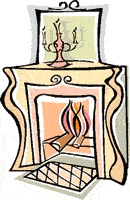Is your fireplace burning money?

When you cozy up next to a crackling fire on a cold winter day, you probably don't realize that your wood-burning fireplace is one of the most inefficient heat sources you can possibly use. It literally sends your energy dollars right up the chimney along with volumes of warm air.
A roaring fire can exhaust as much as 24,000 cubic feet of air per hour to the outside, which must be replaced by cold air coming into the house from the outside. Your heating system must warm up this air, which is then exhausted through your chimney. If you use your conventional fireplace while your central heating system is on, the following tips can help reduce energy losses.
Keep your fireplace damper closed unless a fire is going. Keeping the damper open is like keeping a 48-inch window wide open during the winter; it allows warm air to go right up the chimney.
When you use the fireplace, reduce heat loss by opening dampers in the bottom of the firebox, if provided, or open the nearest window slightly — approximately one inch -- and close doors leading into the room. Lower the thermostat setting to between 50° and 55°F.
Install tempered glass doors and a heat-air exchange system that blows warmed air back into the room. Be sure to close the glass doors when the fireplace is not in use. If you don’t have glass doors, seal the fireplace opening with a tightly-fitting fireplace cover once the fire has died out.
Check the seal on the flue damper and make it as snug as possible. Add caulking around the fireplace hearth.
Use grates made of C-shaped metal tubes to draw cool room air into the fireplace and circulate warm air back into the room.
A fireplace insert can significantly improve your fireplace’s heating efficiency. However, proper installation is essential, using only approved fireplace insulating materials to ensure the insert is airtight. A double-wall fireplace insert is more common, safer and more efficient than a single-wall unit. Some units have fans that may improve heat distribution by 50 to 75 percent.
If you never use your fireplace, plug and seal the chimney flue.
Source: The U. S. Dept. of Energy. For additional information, log on to http://www.eren.doe.gov/consumerinfo/.
Page created and maintained by West Florida Electric Cooperative, Inc. © 2001.
designed by embryo design